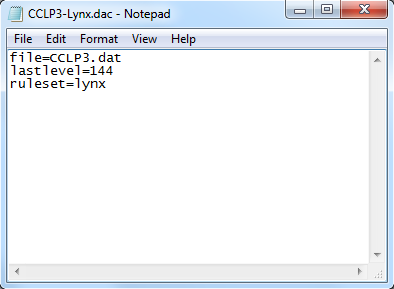Please create an account or Login! Have fun!
DAC
A DAC file is a plain text file with extension .dac, which Tile World reads from the "sets" folder to make a level set playable from Tile World. It is used to specify how Tile World should treat the level set, such as which ruleset to apply, and can be used to create separate solution files. Another way to make a level set playable in Tile World is to put the DAT file in the sets folder, but using DAC files is better because more settings can be specified and updates to the DAT file do not need to be duplicated if the set is being played in both rulesets. A DAC file can be made by a text editor. DacGen, a program in Chip's Controls, can also be used to make DAC files.
As of Tile World 2.2, Tile World automatically generates DAC files for the user.
Parameters[edit]
Only the first parameter, the name of the level set file (the DAT file), is required. The rest are optional and can be in any order.
The parameters are:
- file - The name of the DAT file (including the file extension) in the "data" folder. If the data folder does not contain a file with the name specified in the DAC file, Tile World will report an error in the command prompt and will not display the set in the list of level sets.
- ruleset - The values for this parameter are ms and lynx. The default is MS.
- lastlevel - The level (other than the last level of the set) after which the end screen is shown, e.g. level 144 for CC1, CCLP2, and CCLP3. If this field is missing, the end screen is shown only after the last level of the set.
- usepasswords - The values for this parameter are yes and no. The default is yes.
- fixlynx - The values for this parameter are yes and no. The default is no. This only applies to the original Chip's Challenge level set and, if the value is yes, tells Tile World to use the original Lynx version of the level set, i.e. the "corrupted" version of SPIRALS, the square central room of SKELZIE, and different passwords for four of the levels, among other things.
Example:
